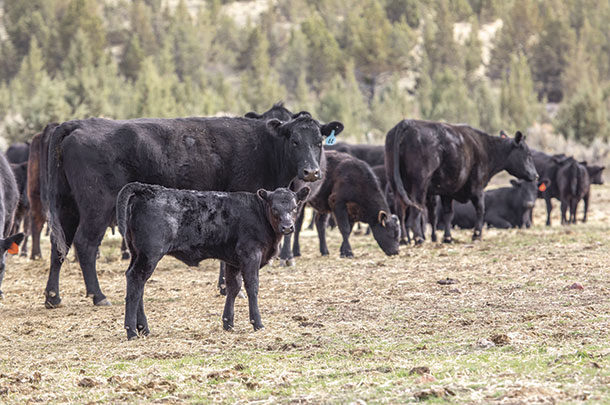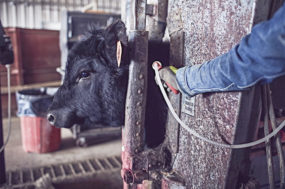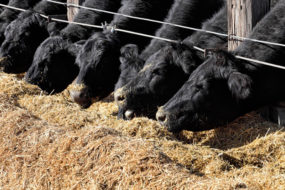Of course, you don’t see them, but forget their existence and, eventually, you’ll see the ugly impact. Luckily, parasite management and even treatment are quite practical. But it does require vigilance, knowledge and a conscious effort to keep ahead of the parasitic life cycle. Proper pasture management coupled with a strategic deworming program can be a simple but vital part of your operation.
The facts of parasitic life
Every animal that grazes pasture carries some sort of internal parasite burden; that’s just a fact of life for a ruminant.
“The cattle industry won’t reach a negative parasite level, and we shouldn’t have that as our goal,” says Dr. Mark Alley, a senior veterinarian with Zoetis Cattle Technical Services. “The ultimate goal is to limit the infection to a level that allows the individual animal to reach his or her genetic potential with minimal economic impact.”
The four most economically important species of nematodes (a phylum of parasitic worm, commonly referred to as roundworms in some species) generally considered in cattle are ostertagia, cooperia, nematodirus and haemonchus. The prevalence of each species is generally dependent on seasonality, environmental conditions and geographic location.
For example, on the Central and Northern plains, pasture larval counts tend to be low in the spring, as many don’t survive the winter. But those that remain and make it to the third larval stage become active in the spring, as they need to rapidly infect a host animal to continue their life cycle.
Parasites become a problem when the load becomes more than an animal’s immune system can manage. There is no magic number on a fecal egg count (FEC) that can tell you the worm-load threshold for any single animal. There are many factors that go into this for each individual before there is an impact on health and well-being.
Certain groups are more susceptible to parasitic infection than others. These include younger animals (up to 2 years old) who haven’t yet acquired maximum immunity and those in a time of immunosuppression, such as prior to and immediately after calving.
Even cows given a drench or topical deworming treatment in the fall or winter will experience some degree of “immune depression” around calving. This allows the remaining adult worms to increase in the post-calving period. If the springtime treatment is not administered at the correct time, with the correct product, larvae will begin to accumulate in pastures. This multiplication takes place through cows and calves, and the animal’s worm burden increases.
Animals that tend to have a very poor immunological response are called “nonresponders.” It is often suggested this group of animals only represents 20 percent of the population, but they may carry 80 percent of the worms and possibly have higher fecal egg counts.
Establishing routine prevention
A subtopic that often comes up when discussing parasitic prevention is pasture rotation. The effective use of pasture can play an important role in your prevention program, as it can reduce the “parasite multiplication effect” that happens with continuous grazing systems. Rotational systems not only help with forage production but can help decrease parasite loads in the environment.
“Grazing management is the foundation upon which an effective internal parasite management program is built,” says Rick Machen of the King Ranch Institute for Ranch Management, Texas A&M University. “Since infestation occurs when the grazing animal consumes infective larvae, preclusion of stock grazing heavily infested pasture or close to the soil surface is the fundamental step in internal parasite management. Application of an appropriate stocking rate and rotational grazing go a long way toward minimizing production losses to parasites.”
“Forcing cattle to graze pastures very short will increase parasite exposure as well,” Alley cautions, stressing the importance of proper rotation that reduces overgrazing.
Turning over soil and re-seeding in the spring can help destroy larvae that have been dormant through the cooler seasons. This can be coupled with a seasonal deworming program that will kill off ingested larvae as the grazing season begins again. Deliberately using strategic deworming with seasonality and systemic grazing greatly increases success with parasitic management in herds of all sizes.
Successful treatment
Anthelmintic (the substance to destroy parasites) efficiency can be affected by different aspects of management. It is also important to make sure your preventative programs are working to benefit your herd, not leading toward increased parasite resistance.
One of the ways your prevention program can work against you and help build resistance is improper dosage of dewormers. Proper dosing on an individual basis or based on the heaviest animals in the group is important, as opposed to dosing for the average of the group.
Another way to avoid resistance may be to avoid anthelmintics altogether if your situation allows it.
“Without question, it can be done, at least in more arid rangeland production scenarios,” says Machen. “I personally know stockmen who have eliminated the use of anthelmintics with effective rotational grazing. The key: short residence time in a particular pasture and the lapse of a long recovery time before stock returns to a pasture. Continuous grazing or unsustainably heavy stocking rate contribute to parasitism, frequent anthelmintic use and anthelmintic resistance development.”
Dr. Phillip Kesterson, veterinarian at Zoetis Cattle Technical Services, offers his thoughts. “Failure to use dewormers judiciously in cattle, including administering the most effective product at the correct time, correct administration and application using the full and appropriate dose, could result in similar challenges to what producers are facing in other species where they cannot control parasites at all.”
Kesterson adds producers should combine diagnostics and veterinary involvement to develop a comprehensive parasite control plan. ![]()
PHOTO: Certain cattle are more susceptible to parasites than others, including animals younger than 2 years old that haven’t acquired maximum immunity. Photo by Mike Dixon.
Jaclyn Krymowski is a freelance writer based in Ohio.








